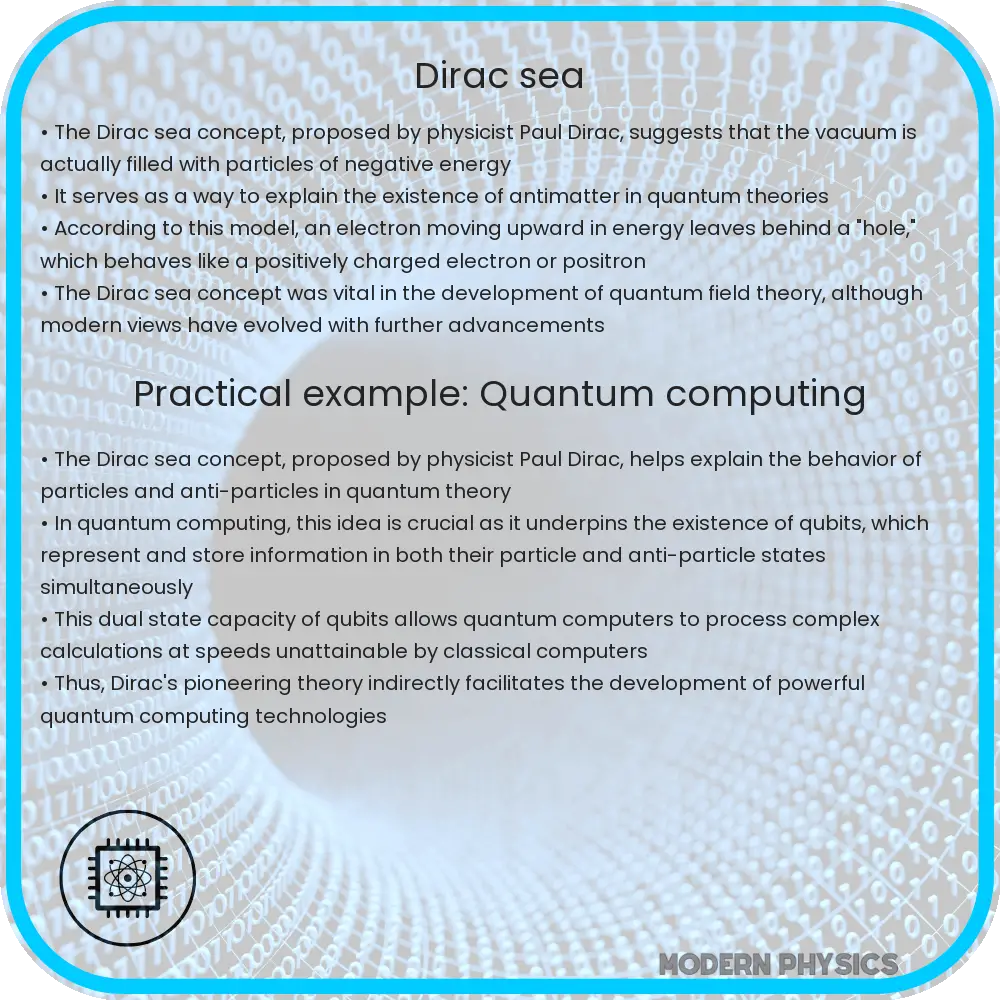Explore the Dirac Sea in quantum theory: Discover antiparticles, QED, and their impact on modern physics and technology. Dive into quantum mysteries.

Exploring the Dirac Sea: A Dive into Quantum Theory and Antiparticles
The concept of the Dirac Sea is a fundamental aspect of quantum theory, pivotal in our understanding of antiparticles and Quantum Electrodynamics (QED). Proposed by Paul Dirac in 1930, this theory revolutionized the way scientists viewed the vacuum and the existence of particles and antiparticles. This article aims to elucidate the complex principles of the Dirac Sea, its implications in quantum physics, and its role in the advancement of QED.
The Genesis of the Dirac Sea
Dirac’s formulation originated from his attempt to reconcile quantum mechanics with special relativity. The Dirac equation, a relativistic wave equation, predicted the existence of particles with negative energy states. To address this, Dirac proposed the Dirac Sea concept, a theoretical sea of negative-energy states. In this sea, all negative energy states are filled, adhering to the Pauli Exclusion Principle, which states that no two fermions can occupy the same quantum state.
Birth of Antiparticles
The remarkable implication of the Dirac Sea was its prediction of antimatter. Dirac theorized that a ‘hole’ in this sea would behave as a positively charged electron, which he termed a ‘positron’. This was not just a theoretical construct; in 1932, Carl Anderson experimentally discovered the positron, validating Dirac’s prediction and opening a new realm in particle physics. The existence of antimatter led to profound questions and explorations about the nature of the universe and the symmetry between matter and antimatter.
Quantum Electrodynamics (QED) and the Dirac Sea
Quantum Electrodynamics, the quantum field theory of electromagnetism, further extended the implications of the Dirac Sea. In QED, particles are seen as excitations in fields, and the Dirac Sea forms a backdrop for understanding particle-antiparticle creation and annihilation processes. This theory provided a framework to understand interactions involving electrons, positrons, and photons, laying the groundwork for much of modern physics.
However, the original concept of the Dirac Sea has evolved. With the advent of Quantum Field Theory (QFT), the idea of an actual sea of particles was replaced by a more abstract but mathematically robust formalism. In QFT, the vacuum is defined not by an infinite sea of particles but as the lowest energy state of a quantum field. This shift underscores the dynamic nature of scientific understanding, where theories evolve and refine over time.
In conclusion, the Dirac Sea remains a cornerstone in the history of quantum physics. Its legacy is reflected in the way we perceive particles, antiparticles, and the quantum vacuum, forming the bedrock of many advanced theories in modern physics.
Advancements and Challenges in Quantum Theory
Building on the foundation laid by the Dirac Sea, contemporary quantum theory has made significant strides. The concept of virtual particles, an offshoot of QED, is central to understanding particle interactions. Virtual particles, transient fluctuations in the quantum field, facilitate force interactions between particles. This concept has been crucial in explaining phenomena such as the Casimir effect and the Lamb shift, further validating the principles of QED.
Implications in Cosmology and Particle Physics
The principles originating from the Dirac Sea theory have profound implications in cosmology and particle physics. For instance, the matter-antimatter asymmetry observed in the universe poses intriguing questions about the early moments of the Big Bang, where equal amounts of matter and antimatter should have been created. This asymmetry remains one of the greatest mysteries in modern physics, with theories like CP violation offering potential explanations.
Technological Impact of Antiparticle Research
Beyond theoretical implications, the study of antiparticles has practical applications. Positron Emission Tomography (PET) scans, a crucial tool in medical diagnostics, utilize positrons to produce high-resolution images of the body. This application demonstrates how fundamental scientific discoveries can have far-reaching impacts beyond their original domains.
The Evolution of the Dirac Sea in Modern Physics
The original concept of the Dirac Sea, while revolutionary, has been refined and reinterpreted through the lens of modern quantum field theory. Today’s physicists view the quantum vacuum not as a literal sea of particles, but as a complex, dynamic entity characterized by fluctuations and virtual particles. This evolution highlights the adaptable and progressive nature of scientific inquiry, where theories are continually tested, refined, and sometimes replaced.
Conclusion
The Dirac Sea, a seminal concept in quantum theory, paved the way for groundbreaking discoveries in particle physics and QED. Its legacy extends from the theoretical prediction and experimental discovery of antiparticles to the intricate workings of the quantum vacuum. While the original concept has evolved, its influence is indelible, underscoring the beauty and complexity of the quantum world. As we continue to unravel the mysteries of the universe, the principles rooted in the Dirac Sea remain a testament to the power of human curiosity and the relentless pursuit of understanding the fundamental nature of reality.
